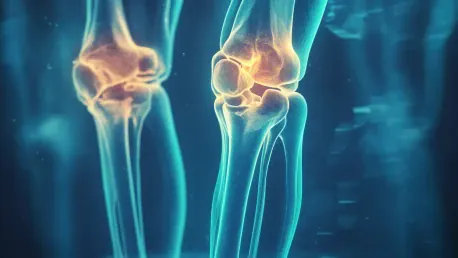Osteosarcoma, a rare and aggressive bone cancer, primarily affects children and young adults during periods of rapid bone growth. Despite its rarity, the impact of osteosarcoma is devastating, often requiring surgery or amputation and posing a high risk of metastasis to the lungs. For decades, the genomic complexity of osteosarcoma has hindered progress in understanding the genetic mutations driving the disease, resulting in limited advancements in treatment.
Breakthrough in Understanding Osteosarcoma Genetics
Discovery of LTA Chromothripsis
Recent research published in the journal Cell has provided pivotal insights into the genetic mechanisms responsible for the aggressive development and evolution of osteosarcoma tumors. This landmark study analyzed the largest collection of whole-genome data from osteosarcoma patients, discovering a novel mutation mechanism termed loss-translocation-amplification (LTA) chromothripsis. LTA chromothripsis was found to be present in approximately 50% of high-grade osteosarcoma cases, elucidating the unique biology underlying the tumor’s aggressive nature and the high levels of genomic instability observed in osteosarcoma cancer cells.
The identification of LTA chromothripsis sheds light on the complex genomic rearrangements that contribute to the aggressive behavior of osteosarcoma. This discovery not only enhances our understanding of the disease but also opens new avenues for targeted therapies that could potentially disrupt these specific genetic mechanisms. By focusing on the unique mutation patterns of osteosarcoma, researchers hope to develop more effective treatments that can improve patient outcomes.
Implications of LTA Chromothripsis
The implications of discovering LTA chromothripsis extend far beyond merely identifying a novel mutation mechanism in osteosarcoma. This insight into the tumor’s biology paves the way for the development of innovative therapeutic strategies that specifically target these genetic alterations. By unraveling the complexities of LTA chromothripsis, researchers can aim to design precision medicine approaches that directly tackle the root causes of the tumor’s aggressive nature, potentially improving treatment success rates and patient survival.
Moreover, understanding LTA chromothripsis may lead to the identification of other genetic factors contributing to osteosarcoma’s progression and treatment resistance. This comprehensive grasp of the tumor’s genetic landscape could inform the creation of combination therapies that counteract multiple pathways involved in tumor development. As a result, patients might benefit from treatments tailored to their tumor’s specific genetic profile, minimizing the likelihood of recurrence and metastasis while maximizing therapeutic efficacy.
Prognostic Biomarkers and Personalized Treatment
Introduction of Loss of Heterozygosity (LOH)
The study also identifies a prognostic biomarker—loss of heterozygosity (LOH)—which could predict patient outcomes and help tailor treatment strategies. LOH, characterized by the loss of one copy of a genomic region, is associated with lower survival probabilities when present at high levels throughout the genome in osteosarcoma patients. This biomarker holds promise for improving patient outcomes through personalized treatment strategies.
Adrienne Flanagan, Professor at UCL and co-senior author of the study, emphasized the clinical importance of LOH. High LOH across the genome predicts lower survival probabilities, which could help identify patients unlikely to benefit from harsh treatments. Providing patients with tailored treatments based on LOH could spare them the unnecessary side effects of toxic therapies, ultimately leading to better quality of life and improved survival rates.
Clinical Importance of LOH
Introducing LOH as a prognostic biomarker is particularly significant because it offers the potential for personalized medicine in treating osteosarcoma. By identifying patients with high levels of LOH, clinicians can determine which individuals are unlikely to respond well to conventional, aggressive treatments. This information allows for the customization of treatment plans, ensuring that patients receive therapies more likely to be effective for their specific genetic makeup, thereby avoiding the adverse side effects of unsuitable treatments.
Moreover, the identification of high LOH as a marker for poor prognosis underscores the necessity of regular genetic monitoring in osteosarcoma patients. By implementing routine genetic screenings, healthcare providers can closely track disease progression and adjust treatment strategies accordingly. This proactive approach not only improves patient outcomes but also contributes valuable data to the ongoing effort to understand the genetic intricacies of osteosarcoma and other cancers.
Collaborative Efforts and Advanced Technologies
Role of Collaborative Research
This groundbreaking research was a collaborative effort involving researchers from EMBL’s European Bioinformatics Institute (EMBL-EBI), University College London (UCL), the Royal National Orthopaedic Hospital, and the R&D laboratory of Genomics England. The project leveraged data from the 100,000 Genomes Project, a pioneering initiative led by Genomics England and NHS England, which sequenced whole genomes from NHS patients affected by rare conditions or cancer.
Collaborative research efforts, such as this project, demonstrate the importance of uniting expertise from various fields to tackle challenging health issues like osteosarcoma. By combining the knowledge and resources of bioinformatics institutes, universities, hospitals, and national health initiatives, researchers can make significant strides in uncovering the genetic complexities of rare cancers. This cooperative approach also fosters an environment of innovation, enabling the development of cutting-edge technologies and methodologies that can drive future discoveries and therapeutic advancements.
Utilization of Advanced Sequencing Technologies
The research also highlighted the crucial role of advanced sequencing technologies in understanding the mechanisms behind the complex genomes of osteosarcoma cells. Isidro Cortes-Ciriano, Group Leader at EMBL-EBI and co-senior author of the study, emphasized the importance of these technologies in analyzing genetic abnormalities across different tumor regions. Through techniques such as long-read sequencing, scientists can gain a comprehensive view of how chromosomal breakages and rearrangements contribute to disease progression, offering valuable insights into the genetic drivers of osteosarcoma.
Advanced sequencing technologies have enabled researchers to conduct large-scale genomic analyses, allowing for detailed exploration of the genetic alterations present in osteosarcoma and other cancers. By examining these abnormalities, scientists can better understand the tumor evolution process and identify potential therapeutic targets. This technological prowess not only enhances our knowledge of cancer biology but also lays the groundwork for the development of targeted treatments that can address the specific genetic makeup of individual tumors, improving patient care and outcomes.
Broader Implications for Cancer Research
Genomic Instability in Various Cancers
The researchers’ broader analysis, which included whole-genome sequencing data from over 5,300 tumors from diverse cancer types, identified that very complex chromosomal abnormalities arise in various cancers due to the instability of chromosomes affected by chromothripsis. This finding suggests that genomic instability observed in osteosarcoma progression is also relevant to other cancer types, highlighting the potential for these insights to inform research and treatment across a range of cancers.
By establishing the connection between genomic instability and various cancers, this research underscores the importance of investigating chromosomal abnormalities in different contexts. Understanding how chromothripsis and similar mechanisms drive tumor development in multiple cancer types could lead to breakthroughs in treatments that address the root causes of genomic instability. As a result, the insights gained from osteosarcoma research might inform strategies to combat a wide array of cancers, ultimately benefiting a larger population of cancer patients.
Impact on Cancer Development Understanding
The identification of complex genomic rearrangements across different cancer types has a significant impact on the overall understanding of cancer development. Jose Espejo Valle-Inclan, co-first author of the study, emphasized the broader implications of the findings, pointing out that investing in studies exploring these mechanisms is crucial for advancing cancer research. By delving deeper into the genetic intricacies of tumor progression, scientists can uncover novel targets for therapeutic intervention, paving the way for more effective and less toxic treatments.
Moreover, the findings from this study highlight the interconnectedness of cancer research. Insights gained from one type of cancer can often inform understanding and approaches to other types, fostering a more comprehensive view of cancer biology. This holistic perspective encourages the sharing of knowledge and resources across different research initiatives, driving innovation and accelerating the development of new treatments that can improve patient outcomes globally.
Future Directions and Patient Care
Potential for Improved Treatment Options
Osteosarcoma is a rare but aggressive form of bone cancer that mainly affects children and young adults, particularly during times of rapid bone growth. Despite its rarity, the disease has a severe impact, often necessitating drastic measures such as surgery or even amputation. One of the most concerning aspects of osteosarcoma is its high risk of spreading, or metastasizing, to the lungs, which complicates treatment and prognosis.
For many years, the complexity of the osteosarcoma genome has posed significant challenges for researchers attempting to decode the genetic mutations responsible for the disease. This complexity has been a major obstacle in making significant progress in understanding the underlying causes of osteosarcoma. As a result, advancements in treatment options have been limited, and patients often face a grim outlook. Despite these challenges, ongoing research is crucial for developing more effective therapies and improving outcomes for those affected by this daunting disease.









